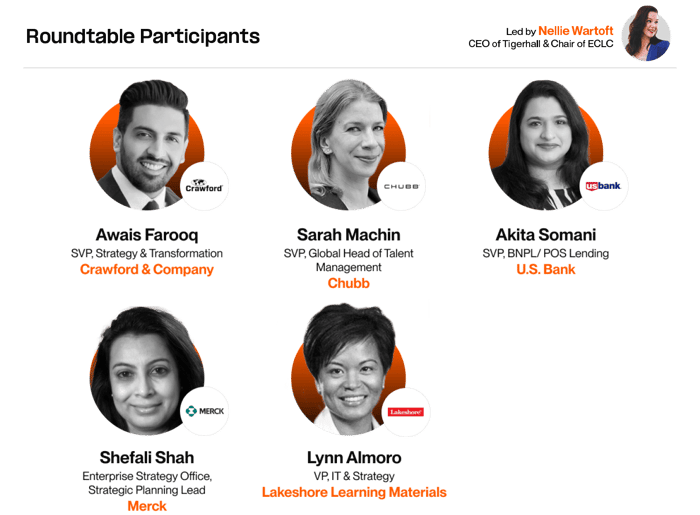In an era marked by relentless transformation and the increasing velocity of change, organizations grapple with the phenomenon of change fatigue more than ever. The Executive Council for Leading Change (ECLC) held a roundtable to dissect this challenge and deep dive into the heart of maintaining momentum and keeping the energy of change initiatives up in the face of organizational and global shifts.

Decline in Change Momentum: Causes and Strategies
A common thread was the acknowledgment of a significant downturn in enthusiasm for ongoing change initiatives, traced back to an array of factors including the lasting impact of global disruptions like the COVID-19 pandemic. This acknowledgment paved the way for a deep dive into actionable strategies aimed at reinvigorating organizational commitment to change.
Understanding Change from the Ground Up
The group stressed the importance of grasping the root causes of change fatigue, recognizing it as the first step toward addressing it. A nuanced understanding of employees' experiences and perceptions can highlight the pathway to more effective engagement strategies.
Communicating with Purpose and Clarity
Amid the sea of ongoing updates and directives for employees, clear and purpose-driven communication stands out. The conversation highlighted the need for messaging that goes beyond the superficial, offering employees a clear understanding of the 'why' behind changes, facilitating a deeper connection with the organization’s trajectory.
Leadership's Role in Energizing the Workforce
Leadership’s genuine engagement with change initiatives was identified as a key factor for the wider organization. Participants emphasized the difference it makes when leaders not only endorse but actively participate in the change process, modeling resilience and commitment.
Valuing the Journey & Recognizing Efforts
Celebrating milestones, no matter how small, was pointed out as a crucial element in keeping spirits high. Recognition was discussed not just in terms of achievements but also as a way to value the learning process, acknowledging that growth often comes from navigating through challenges.
Empowerment through Participation
Encouraging employees to take active roles in change initiatives transforms them from observers to participants. This shift can significantly enhance their investment in the outcome, creating a more inclusive atmosphere that values contributions at all levels.
4 Successful Approaches and Tactics
1. Engaging in Active Listening
Emphasize the importance of listening to employee feedback and concerns so as to tailor approaches that resonate on an individual level.
Active listening involves a dynamic and empathetic process where feedback is not only solicited but genuinely considered in the decision-making process. This approach enables leaders to understand the personal and professional anxieties that change might stir in employees, thereby crafting solutions that address these concerns directly. For example, if employees express apprehension about new technologies, a response could be to introduce more hands-on training sessions, aligning solutions closely with identified needs.
2. Flexible Implementation
Adopt a flexible approach to change initiatives, allowing for adjustments based on feedback and evolving circumstances.
Change is not a one-size-fits-all process. A flexible approach acknowledges the diverse nature of teams and projects, allowing for real-time adjustments to strategies based on ongoing feedback and the specific circumstances encountered. This might mean adopting a phased rollout of new initiatives rather than a company-wide launch, or allowing teams to have a say in the pacing of these changes. Such adaptability not only makes change more manageable for all involved but also demonstrates a commitment to a participatory change process.
3. Providing Resources for Adaptation
Equip employees with the resources, training, and support needed to navigate change effectively.
Beyond announcing changes, successful change leadership involves equipping employees with the necessary tools, knowledge, and support structures to adapt with confidence. This could involve creating comprehensive learning modules, providing access to mentors or coaches who can guide employees through transitions, establishing help desks to address immediate concerns, or using a platform like Tigerhall to roll out change. By investing in resources made to navigate through change, organizations can significantly reduce resistance and enhance the overall change experience.
4. Building Resilience
Focus on developing organizational resilience through continuous learning and adaptability.
Organizational resilience is the cornerstone of sustainable change. Cultivating this quality involves encouraging a mindset of continuous learning and adaptability across the organization. This could be achieved through regular training sessions focused on developing soft skills, creating forums for sharing lessons learned from past change initiatives, and building a culture where feedback is seen as a valuable tool for growth. Resilience is about surviving change and thriving through it.
2 Common Challenges Faced
1. Navigating External Pressures
The compounded impact of global events and societal changes presents a unique challenge to maintaining focus and enthusiasm for internal change initiatives.
The backdrop of global uncertainties—from pandemics to economic fluctuations—adds layers of complexity to internal change initiatives. These external pressures can distract focus and dilute enthusiasm for change as employees and leaders alike grapple with uncertainties that extend beyond the office walls. Successful navigation requires transparent acknowledgment of these pressures and integrating support systems that address the broader context affecting employee well-being and focus.
2. Aligning Diverse Expectations
Balancing the varied expectations and experiences of employees across different organizational levels and departments.
Diverse employee expectations represent a significant challenge in harmonizing change efforts. Discrepancies in how change is perceived and received can vary widely across departments, levels of seniority, and individual roles. To address this, change leaders need to engage in open dialogues to understand the specific expectations and reservations of different groups within the organization. Tailoring communication and involvement strategies to these varied expectations can help in aligning everyone towards a common goal, making the change journey a more inclusive and unified effort.
6 ECLC Member Contributions on Navigating Change Fatigue
The roundtable discussion provided a platform for ECLC members to share their deep insights and strategies for tackling the nuanced challenges of change fatigue. Here's a closer look at their contributions:
1. Shefali Shah: Overcoming Resource Scarcity and Implementation Focus
Shefali Shah talked about the realities of spearheading change initiatives within a huge organization. The scarcity of support and the constant battle for resources emerged as critical hurdles. Shah's strategy focuses on the pragmatic aspect of execution, emphasizing the necessity of pushing through limitations to achieve the desired outcomes. Her insights underscore the importance of adaptability and resourcefulness in driving change within organizational constraints.
2. Lynn Almoro: Challenges of Change Initiatives Across Hierarchy
Lynn Almoro's experience with change initiatives revealed a dual challenge: securing top-level sponsorship and managing frontline resistance. Her approach stresses the importance of clear communication and the need for compelling narratives to garner executive buy-in. Furthermore, Almoro highlighted strategies for engaging frontline employees to minimize resistance, emphasizing the crucial role of inclusivity and direct involvement in fostering a collective commitment to change.
3. Collective Insight: Equip Employees to Thrive Through Change
The dialogue underscored a common concern regarding the toll of change fatigue on employees, with a consensus on the urgent need to supply junior staff with the skills to manage change effectively. This shared perspective highlights a gap in many change management strategies—preparing employees across all levels not just to survive but to thrive amid change, emphasizing the development of resilience and adaptability as key competencies.
4. Collective Insight: Navigating Organizational Dynamics and Political Resistance
The conversation between Shefali Shah and Lynn Almoro touched upon the nuanced challenges of implementing change, particularly the resistance stemming from internal politics and the desire to maintain the status quo. They discussed the complexities of navigating leadership changes and the resistance fueled by concerns over loss of control or influence, pointing to the necessity of strategic maneuvering and relationship-building to overcome these obstacles.
Akita Somani on Leadership and Change: "Leadership’s commitment to change is instrumental in guiding the organization through the complexities of transformation."
Awais Farooq on the Faster Pace of Change: "For strategic initiatives, the shift is moving towards delivering smaller, more manageable pieces at a faster pace, as opposed to the traditional 'big bang' approach of unveiling comprehensive changes all at once."
5. Lynn Almoro on Strategic Implementation and Advocacy
Proposing a methodical approach to change, Lynn Almoro advocated for prioritizing process and data modifications ahead of altering people dynamics. She emphasized the power of cultivating advocacy among business stakeholders to enhance receptivity to change. This strategy suggests a layered approach to change implementation, where the order of operations and the development of internal champions are key in reducing resistance and fostering an environment of acceptance and support.
6. Collective Insight: Managing Political Dynamics and Empirical Resistance
The roundtable tackled the delicate issue of managing politics within organizational change, highlighting the challenges of empire-building and protectionism among senior leaders. The discussion revolved around understanding the motivations of key stakeholders and the criticality of building robust relationships to navigate the political landscape effectively. These insights highlight the importance of political acumen and strategic relationship management in surmounting the hurdles that internal politics present to change initiatives.
Conclusion
The roundtable conversation highlighted a pragmatic approach to dealing with change fatigue. It revealed that the essence of sustaining momentum in change initiatives lies in genuine engagement, tailored communication, and strategic patience.
The insights emphasized were not about lofty ideals but about concrete actions:
- Listening deeply to understand the concerns at the frontline,
- Adapting plans to meet emerging needs,
- Equipping teams with the right tools and knowledge, and
- Cultivating a culture where resilience is built on real learning and shared successes.
As organizations look forward, the discussion from this roundtable offers a blueprint for navigating change with a focus on the human element—acknowledging the challenges, celebrating the small wins, and moving forward with a shared purpose. In navigating the road of continuous change, the journey is as significant as the destination, shaped by the collective resilience, adaptability, and insight of those leading the way.
The Executive Council for Leading Change
The Executive Council for Leading Change (ECLC) is a global organization that brings executives together to redefine the landscape of organizational change and transformation. Our council's aim is to advance strategic leadership expertise in the realm of corporate change by connecting visionary leaders. It's a place where leaders responsible for significant change initiatives can collaborate, plan, and create practical solutions for intricate challenges in leading major shifts in large organizations.
In a world where change is constant, we recognize its crucial role in driving business success. ECLC’s mission is to create a community where leaders can excel in guiding their organizations through these dynamic times.
Interested in joining ECLC? Learn the membership criteria and sign-up below.
To download this executive brief, click here.

